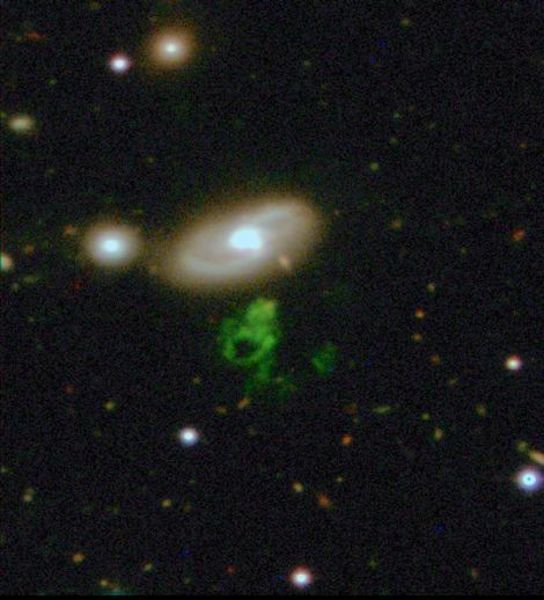
The mysterious cloud was discovered in 2007, by Dutch school teacher Hanny van Arkel while combing though images for the Galaxy Zoo galactic classification project.
Located near the spiral galaxy IC 2497 some 700 million light years away in the constellation Leo Minor, it is known as Hanny's Voorwerp, which is Dutch for Hanny's object.
What makes Hanny's Voorwerp astounding is that it is so unusual - a monstrous green blob with a huge central hole some 16,000 light years across.
Although galactic in scale, it is clearly not a galaxy because it does not contain stars.
Spectrographic readings confirmed it is a giant gas cloud.
But astronomers could not explain why it was glowing an unusual bright green colour.
Last year scientists proposed that some 10,000 years ago, IC 2497 suddenly underwent a dramatic outburst of quasar-like radiation and then became quiet. What we see today is simply a reflection of that outburst.
In other words, Hanny's Voorwerp is a quasar light echo.
The problem with that idea was that nobody knew what could cause an entire galaxy to flare up briefly and suddenly.
Ionised gas
Now a team of scientists led by Hayden Rampadarath from the Joint Institute for VLBI in Europe, based in the Netherlands, think they have a more plausible answer.
Published on the pre-press website ArXiv.org and accepted for publication in Astronomy and Astrophysics, Mr Rampadarath and colleagues studied the region at various wavelengths.
They found that, like many galaxies, IC 2497 contains a supermassive black hole at its centre.
The infall of matter into the black hole generates a cone of radiation which is ionising the gas in Hanny's Voorwerp, causing it to glow green.
What has confused the issue is that another cloud of dust and gas sits between Earth and IC 2497, which prevents us from directly seeing the black hole.
Dr Darren Croton, a theoretical astrophysicist at Melbourne's Swinburne University, says "evidence that IC 2497 is still active puts an end to the light echo theory, which is a pity because it was a nice idea".
"It also explains why Voorwerps are so rare, the radiation cones from active galactic nuclei are highly directional so gas clouds would only get illuminated occasionally," he said.
According to Dr Croton the study shows there is a lot of gas in intergalactic space.
"It's just hard to see," he said.
"But thanks to this nearby active galactic nuclei we can see it's there."



Reader Comments
to our Newsletter